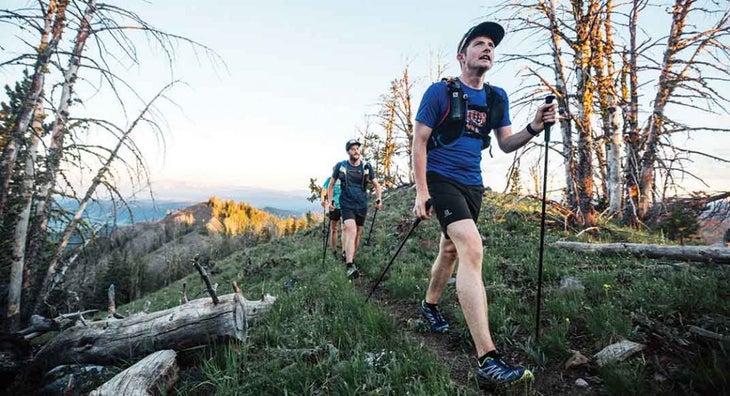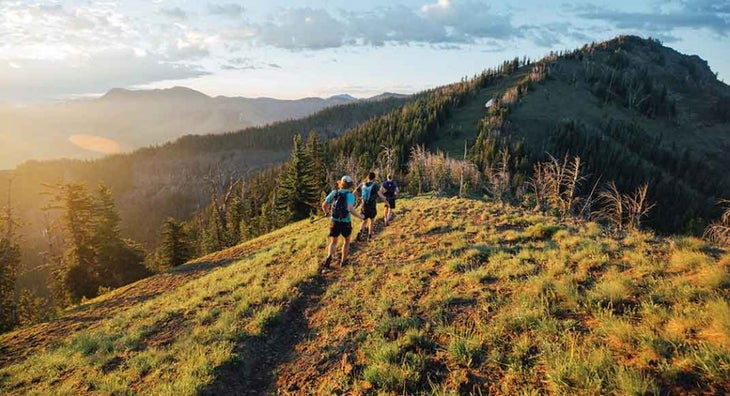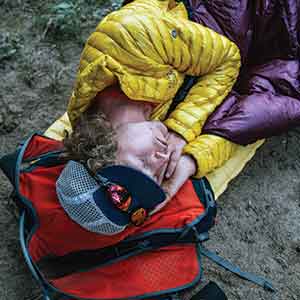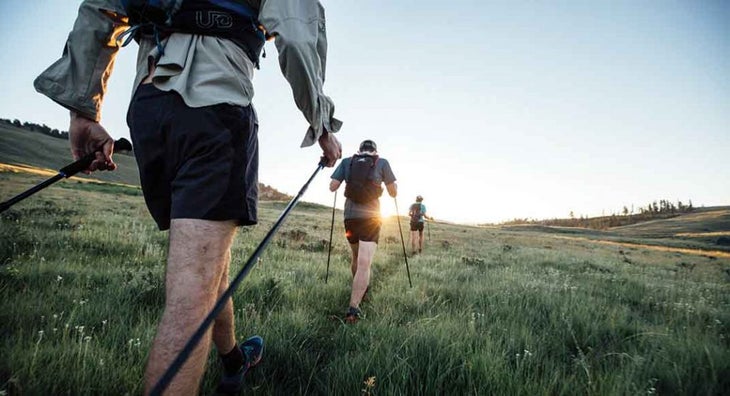New perk! Get after it with local recommendations just for you. Discover nearby events, routes out your door, and hidden gems when you sign up for the Local Running Drop.
“Birds make great sky circles with their freedom. How do they do that? They fall. And in falling, they are gifted wings.” —Rumi
Dave recited these words as we stood in the hopeful, golden light of a cool summer morning. Anthony Pavkovich, Dave Laufenberg, both 29, and I, 24, had convened on Anthony’s lawn in Bozeman, Montana. Everything we would need for the coming week was in coolers and plastic bins: stoves, water tanks, cameras, tents and bedding, maps, running vests, several pairs of running shoes each, food, gels and chews and more books than time would possibly allow.
We were preparing for what would amount to our greatest and most challenging adventure: a seven-day, 236-mile traverse of the Greater Yellowstone Ecosystem (GYE). We stood within a circle of friends who had gathered to see us off on our journey from Bozeman to Red Lodge, Montana.
“Guys, shall we go for a jog?” Anthony said, a sardonic grin on his face. It felt laughable, in light of how enormous this trip would be. The three of us were embarking on this journey to celebrate the wonderful public lands in our backyard; by showcasing the scale and beauty of the GYE, we hoped to help ensure its continued existence.
Anthony possesses a level-headed sureness about adventure pursuits and an objective understanding of others’ abilities, in addition to his own. This likely stems from his mountaineering background, where he developed the ethic of moving fast and light, eventually trading the heavy packs of climbing gear for a pair of running shoes. With or without a heavy pack, Anthony is a fantastic mule.
After bamboozling me to join his wild scheme, Anthony recruited Dave, whom I met last fall at a courthouse rally supporting the Standing Rock Sioux Tribe of North Dakota, a community that was resisting the construction of the Dakota Access Pipeline across their tribal lands. A native of the backwoods of Wisconsin, Dave spent two years as a naturalist guide in Yellowstone National Park, and is now working on a Master’s degree in the Ecology Department at Montana State University, studying white-bark pine in the GYE. With his lanky frame, glasses and a permanent grin fixed on his bearded face, Dave possesses the knowledge of a landscape ecologist and is shaped by a deep emotional intelligence. He can also make you laugh, no matter how bad the situation. He’s a good guy to have in the backcountry.

GALLATIN RANGE
The next morning, as the sun was rising, we summited Hyalite Peak, the pyramid-shaped keystone of the northern Gallatins. To the north rested our starting point, the city of Bozeman, already a shimmering image in the early heat trapped in the valley.
“It feels so good to be out!” I yelled into the wind.
The Gallatins are our home range, a family of snow-capped peaks, jagged and familiar. Still blessed with fresh legs, we gazed optimistically to the south at the 30 more miles of high-alpine ridgeline that we would run before meeting our crew at the first camp.
“You guys see those goats?” Anthony said, pointing to the scattered white specks below a cliff band.
I continued running the undulating ridgeline past alpine wildflowers toward Anthony, who was snapping photos. I squinted at the specks.
“I think those are rocks, bud.”
We laughed. This isn’t the first time we’ve identified wildlife, only to later discover a pile of boulders.
After descending the backside of Hyalite Peak, Dave waded out into the waist-deep waters of Crater Lake. He sported a navy-blue shirt, dark sunglasses and a big straw hat, large enough to be considered a sombrero.
“This is gonna be a good week for swimming,” he said, as Anthony and I sat patiently on the shore in a swarm of black flies.
Related: Monumental Controversy, Why Why Westerners disagree on protecting public lands.
This trip came to its final form on the steps of the Montana State Capitol Building in Helena, on January 30, 2017. Accompanied by 1,000 other Montanans, Anthony, Dave and I crammed into the chambers of the Capitol to rally against the sale or transfer of public lands. The decorative marble floor and balconies overflowed with people representing a variety of user groups: hunters, anglers, hikers and motorized users. To this day, the words of Governor Steve Bullock, his face red and the veins in his neck bulging with the exertion of delivering his passionate speech, still ring in my ears, “These lands are our heritage!”
In order to celebrate our backyard federal public lands and highlight the factors that make them so significant, Anthony had designed a route through the GYE that would put us near a crew-accessible campsite each night, allowing us to travel light and fast.
The GYE is the largest relatively intact swath of wild country remaining in the contiguous United States. It is a 20-million-acre mosaic of land, which is largely publicly owned. The GYE provides crucial habitat to some of North America’s most iconic megafauna: grizzly bears, wolves, moose, bison, elk, mountain lions and wolverines. The region is also host to a myriad of geologic processes, with the Yellowstone Caldera taking center-stage as a powerhouse to the largest concentration of geysers in the world. In the high country, there are numerous fast-retreating, alpine glaciers alongside crystal-clear lakes, vestiges of a time when most of the GYE was covered in glacial ice. It is an untamed place.
The wilderness asserted itself immediately. After six hours, we rolled into camp on the first evening, as a heavy thunderstorm cracked open. While most of the crew huddled in the cold like penguins beneath a large pop-up tent, Seth, our project photographer, was crouched in a smaller adjacent tarp nearby, shooting the scene.
“Feels like I’m in the servant’s quarters,” he joked.

YELLOWSTONE NATIONAL PARK
The next major segment was in the northern section of Yellowstone National Park (YNP). On day three, 10 miles in from any trailhead, we stood on the shore of Sportsman Lake, tucked into one of the most remote regions in the park. During the 1988 fires that ravaged most of YNP, the area surrounding Sportsman Lake was consumed by the flames. In the midday heat, over 90 miles into the trip, I looked up at our final big climb of the day: three miles with 2,500 feet of climbing through hot, exposed, charred-skeleton forest to a rocky ridge. Amid a relentless swarm of black flies, we filled up our water and marshaled upward.
Cresting the climb, we dropped into a lush drainage to find our support crew, who had hiked 10 miles to deliver snacks and positive energy. Dave, as usual, immediately parked himself in the stream, happily drinking a PBR; however, the giddiness from exhaustion, heat and good company had me feeling intoxicated enough.
“My, how life can change in just a few miles,” I said, sitting in the shade in a state of Oreo- and coconut-water-induced euphoria.
Just a few miles later, though, my high spirits deflated. My feet had become very tender, and soon I slowed to a walk. Fortunately, Anthony and Dave didn’t seem to mind.

In the soft, evening light, we plodded into the parking lot of Mammoth Hot Springs, where we were met by friends from nearby Gardiner, just outside the park. We hopped in their vehicle for a ride to town, where bison burgers awaited.
Sitting in our friend’s living room, I studied my feet. The bottoms were bony white, and the rock-hard surface was splitting open like a peach. I could barely walk across the room, and tomorrow would be our biggest day of the week—44 miles across the hottest section of the park. As I contemplated my ability to continue, Anthony swore under his breath, trying to close his duffel bag, visibly exhausted. Dave discussed tomorrow’s logistics with the crew, hovered over maps on a table.
Our 3 a.m. wakeup call came too soon. Fortunately, my feet looked better, and I taped them up. Even just a few hours of rest can do wonders for morale, and we were optimistic on the drive back to the trailhead.
Trotting through the tunnel vision of our headlamps along a plateau scented with sagebrush and juniper, Anthony attempted to bolster our spirits: “After today, our mileage will taper. Things will get better.”
“44 miles? I could limp that!” Dave replied, in a faux-southern drawl.
A few miles later, in the faint predawn light, we saw two figures running towards us. It was Seth and Tianse, a filmmaker who is documenting the trip for Done With It Productions.
“Woohee!” Hoots and hollers echoed in the darkness. The friendly faces breathed new life into our spirits. In a pack, we ran across the suspension bridge above the raging Yellowstone River.
In the film, Tianse will cover a growing environmental threat to the communities along the Yellowstone River, as well as the threat to public lands surrounding Yellowstone National Park. For the past several years, a Canada-based mining company, Lucky Minerals, has been working to open a gold mine in Emigrant Gulch, a tributary of the Yellowstone River. And in July 2017, despite widespread opposition from local communities and the Greater Yellowstone Coalition (GYC), the Montana Department of Environmental Quality approved Lucky Mineral’s exploratory drilling project, a significant step in the development of the mine.
That same week, U.S. Senator Jon Tester’s Yellowstone Gateway Protection Act, which would permanently withdraw the mineral rights from 30,000 acres of public land in the area, received a hearing with the Senate Energy and Natural Resources Committee. “I have never seen [legislation] move this fast,” says Darcie Warden, the Montana Conservation Coordinator for the GYC. A committee hearing is the first step for a bill to become a law.
We continued through the heat of the day, crossing the dry prairie like a herd of elk, careful to give the occasional lone bull bison ample distance as we passed.
“A few more miles and our longest day will be over,” Dave said, as, after 16 hours on the move, we forded the Lamar River, which weaved through the valley like a snake. Rejuvenated by the cooling dip, we started running again for the first time in over 12 hours, a small triumph.

BEARTOOTH PLATEAU
It hurts!” I blurted, clenching my teeth. Anthony worked to relieve the pressure of my swollen shins, squeezing them like a tube of toothpaste. Within the dark tunnel of discomfort, the presence of the Beartooth Mountains, our final section of the trip, offered healing power. Surrounded by high peaks of polished white granite, we rested on the edge of an alpine lake, still iced over and framed by snow drifts in the middle of July. A jagged range thoroughly dissected by glaciers, the Beartooths feature an abundance of alpine lakes.
“One more huge hill,” said Anthony, as he massaged my aching shins. The final leg of our journey would bring us over the Red Lodge Plateau, a treeless, alien world offering no protection from the storm cells that frequently park themselves over the Beartooths.
But, today, as we traversed high-tundra landscape, the clouds clotted into an angry but benign grey mass. The high winds behind pushed us along and down into the mountain settlement of Red Lodge, population 2,200. Hobbling down the main drag, we were joined by our crew, now two-dozen strong, for our final steps.
I define home to be the places you can reach on foot from your front door. After seven days, 236 miles, and 42,000 vertical feet on very little sleep, my home had gotten bigger.
Zach Altman is a writer and adventurer living in Bozeman, Montana. To learn more about the issues affecting the GYE and the upcoming film, visit commongroundmt.com.